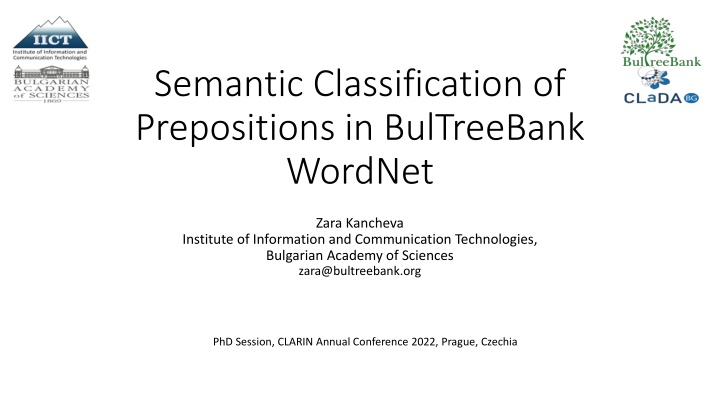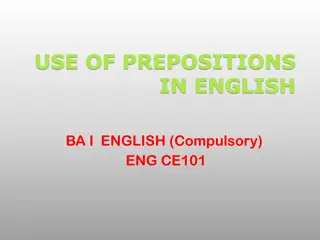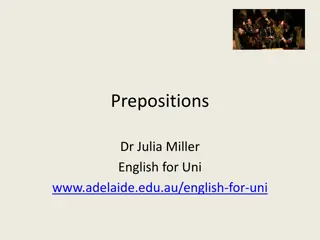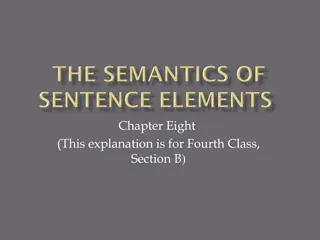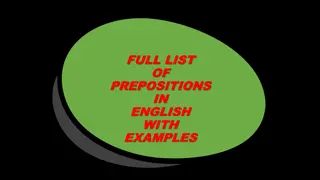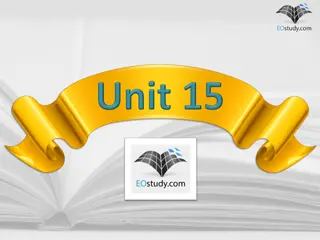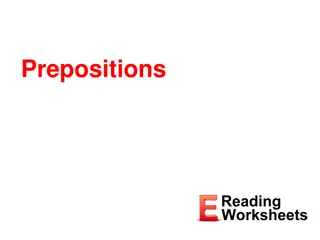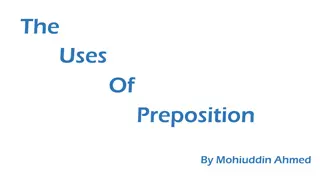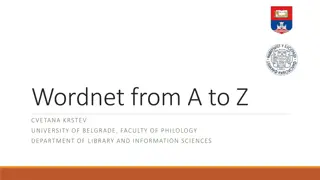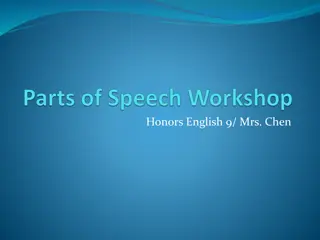Semantic Classification of Prepositions in Bulgarian WordNet: A Comprehensive Overview
This presentation delves into the semantic classification of prepositions in the BulTreeBank WordNet, focusing on the incorporation of prepositions, closed-class words, and the benefits for neural model building in Bulgarian language processing. The motivation behind the study, challenges posed by polysemy, and the adapted version of preposition classification with 15 categories are discussed. Additionally, a detailed model for preposition synsets in BTB-WN is outlined, covering definitions, synonyms, examples, semantic classes, and relations with other parts of speech.
Download Presentation

Please find below an Image/Link to download the presentation.
The content on the website is provided AS IS for your information and personal use only. It may not be sold, licensed, or shared on other websites without obtaining consent from the author.If you encounter any issues during the download, it is possible that the publisher has removed the file from their server.
You are allowed to download the files provided on this website for personal or commercial use, subject to the condition that they are used lawfully. All files are the property of their respective owners.
The content on the website is provided AS IS for your information and personal use only. It may not be sold, licensed, or shared on other websites without obtaining consent from the author.
E N D
Presentation Transcript
Semantic Classification of Prepositions in BulTreeBank WordNet Zara Kancheva Institute of Information and Communication Technologies, Bulgarian Academy of Sciences zara@bultreebank.org PhD Session, CLARIN Annual Conference 2022, Prague, Czechia
Introduction Preposition incorporation in BulTreeBank WordNet Closed class words typically missing in wordnets Semantic classification compiled from Bulgarian grammars The integration will benefit neural models building for Bulgarian A wordnet for Bulgarian which is suitable for semantic annotation will be available in the framework of CLARIN and will provide processing of semantically annotated corpora
Motivation Substantial role in many NLP tasks, but polysemy constitutes one of the greatest challenges for this research area Seriously benefit the utility of wordnets for semantic annotation, language models, text analysis and generation, word-sense disambiguation, automatic translation, etc.
Classification of prepositions The adapted version of the classification of prepositions contains 15 categories: location, time, transition, manner and instrument of action, possession, quantity, degree and exceeding of limit, purpose, origin and part of a whole (example (1)), opposition, comparison, cause and object class: exchange, exclusion, opinion and thought (1) Polu ih vesti ot I recieved news from the homeland. rodinata. Synset categories for prepositions in BTB-WN: prep.location, prep.time, prep.transition, prep.manner, prep.purpose, prep.origin, prep.opposition, prep.comparison, prep.cause, prep.obj.exchange, prep.obj.exclusion, prep.obj.thought prep.possession, prep.quantity, prep.obj.opinion and
Model for preposition synsets in BTB-WN Detailed definition, synonyms and examples Semantic classes of prepositions > categories of the synsets Relations between prepositions and other parts of speech (for example, the verbs pretend and turnin combined with express transition in new, different state) Relations between preposition synsets (for example, the synset of ( on ) with definition Location relation in which something is located on some surface has a synonym , on , and also has an antonym relation with the synset for , under )
Conclusion and future work Large-scale integration of prepositions in BTB-WN, motivated by various NLP applications Semantic preposition classification Combinations of verbs and prepositions which express specific senses are going to be further explored The analysis will be elaborated with hierarchy inheritance and categorization of the verbs and nouns in wordnet, more relations and with features from a valency lexicon Good coverage of prepositions in wordnet > better quality of language models
